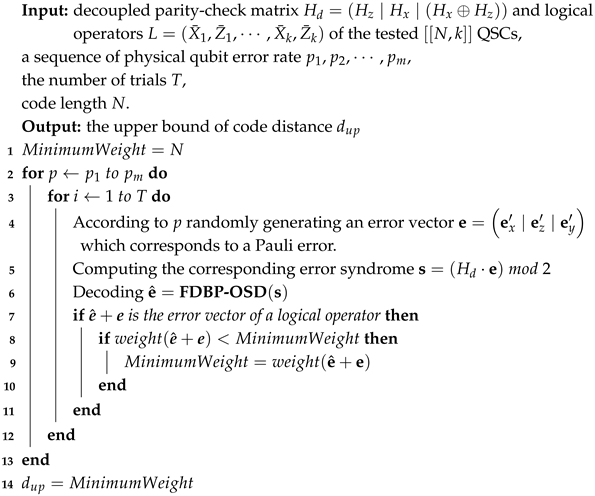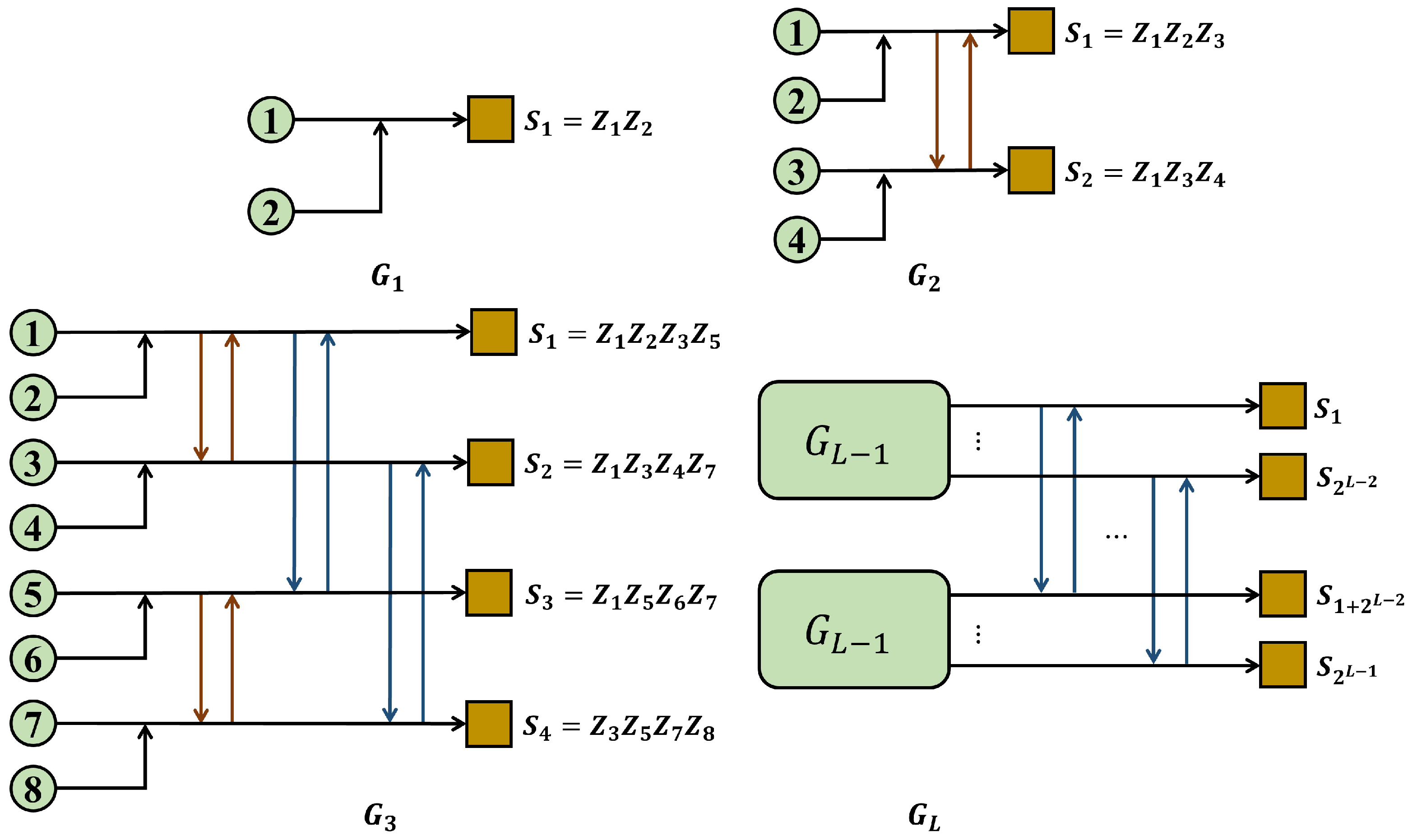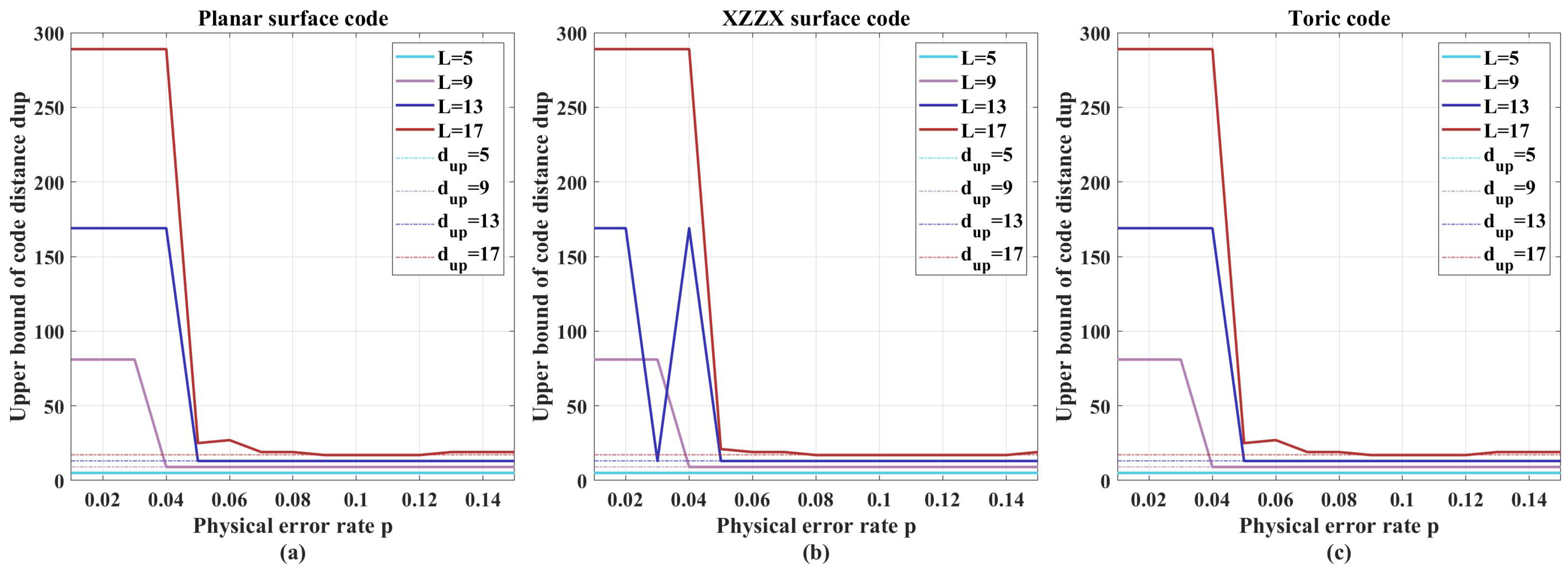Determining the Upper-Bound on the Code Distance of Quantum Stabilizer Codes Through the Monte Carlo Method Based on Fully Decoupled Belief Propagation
Abstract
1. Introduction
2. Preliminaries
2.1. Quantum Stabilizer Code
2.2. Z-Type Tanner-Graph-Recursive-Expansion Code
2.3. XYZ Product Code
3. Determining the Upper Bound of Code Distance
3.1. Monte Carlo Method
3.2. Fully Decoupled Belief Propagation
- (1)
- Decoupling Pauli representation: We encode single-qubit Pauli operators using three bits (Definition 1), decoupling Y-error correlations.
- (2)
- Decoupled parity-check matrix: Based on (1), we construct a decoupled parity-check matrix (Definition 2)
- (3)
- Constraint message passing: The representation enforces for any qubit . We modify message-update and hard-decision rules to incorporate this constraint.
3.3. Algorithm
| Algorithm 1: Determining the upper bound of code distance based on FDBP-OSD. |
 |
4. Simulation Results
- (1)
- The computed upper bounds match the known code distances, demonstrating high algorithm precision.
- (2)
- At low error rates, the upper bound equals the code length (used as the initial value in simulations). This occurs because the high performance of FDBP-OSD ensures all decoding trials succeed.
- (3)
- Simulations indicate that near , the algorithm more reliably converges to upper bounds close to the true code distance.
5. Conclusions
Author Contributions
Funding
Data Availability Statement
Conflicts of Interest
Abbreviations
| QSC | quantum stabilizer code |
| Z-TGRE | Z-type Tanner-graph-recursive-expansion |
| CSS | Calderbank–Shor–Steane |
| QLDPC | quantum low-density parity check |
| BP | belief propagation |
| FDBP | fully decoupled belief propagation |
| OSD | ordered statistics decoding |
References
- Shor, P.W. Algorithms for quantum computation: Discrete logarithms and factoring. In Proceedings of the 35th Annual Symposium on Foundations of Computer Science, Santa Fe, NM, USA, 20–22 November 1994; pp. 124–134. [Google Scholar]
- Shor, P.W. Scheme for reducing decoherence in quantum computer memory. Phys. Rev. A 1995, 52, R2493–R2496. [Google Scholar] [CrossRef] [PubMed]
- Steane, A.M. Error Correcting Codes in Quantum Theory. Phys. Rev. Lett. 1996, 77, 793–797. [Google Scholar] [CrossRef] [PubMed]
- Gottesman, D. Stabilizer Codes and Quantum Error Correction; California Institute of Technology: Pasadena, CA, USA, 1997. [Google Scholar]
- Bravyi, S.B.; Kitaev, A.Y. Quantum codes on a lattice with boundary. arXiv 1998, arXiv:quant-ph/9811052. [Google Scholar] [CrossRef]
- Fowler, A.G.; Mariantoni, M.; Martinis, J.M.; Cleland, A.N. Surface codes: Towards practical large-scale quantum computation. Phys. Rev. A 2012, 86, 032324. [Google Scholar] [CrossRef]
- Bonilla Ataides, J.P.; Tuckett, D.K.; Bartlett, S.D.; Flammia, S.T.; Brown, B.J. The XZZX surface code. Nat. Commun. 2021, 12, 2172. [Google Scholar] [CrossRef]
- Kitaev, A.Y. Fault-tolerant quantum computation by anyons. Ann. Phys. 2003, 303, 2–30. [Google Scholar] [CrossRef]
- Hamma, A.; Zanardi, P.; Wen, X.G. String and membrane condensation on three-dimensional lattices. Phys. Rev. B 2005, 72, 035307. [Google Scholar] [CrossRef]
- Castelnovo, C.; Chamon, C. Topological order in a three-dimensional toric code at finite temperature. Phys. Rev. B 2008, 78, 155120. [Google Scholar] [CrossRef]
- Breuckmann, N.P.; Duivenvoorden, K.; Michels, D.; Terhal, B.M. Local decoders for the 2D and 4D toric code. arXiv 2016, arXiv:1609.00510. [Google Scholar] [CrossRef]
- Tillich, J.P.; Zémor, G. Quantum LDPC codes with positive rate and minimum distance proportional to the square root of the blocklength. IEEE Trans. Inf. Theory 2013, 60, 1193–1202. [Google Scholar] [CrossRef]
- Landahl, A.J.; Anderson, J.T.; Rice, P.R. Fault-tolerant quantum computing with color codes. arXiv 2011, arXiv:1108.5738. [Google Scholar] [CrossRef]
- Kapshikar, U.; Kundu, S. On the hardness of the minimum distance problem of quantum codes. IEEE Trans. Inf. Theory 2023, 69, 6293–6302. [Google Scholar] [CrossRef]
- Rubinstein, R.Y.; Kroese, D.P. Simulation and the Monte Carlo Method; John Wiley & Sons: Hoboken, NJ, USA, 2016. [Google Scholar]
- Panteleev, P.; Kalachev, G. Degenerate Quantum LDPC Codes with Good Finite Length Performance. Quantum 2021, 5, 585. [Google Scholar] [CrossRef]
- Bravyi, S.; Cross, A.W.; Gambetta, J.M.; Maslov, D.; Rall, P.; Yoder, T.J. High-threshold and low-overhead fault-tolerant quantum memory. Nature 2024, 627, 778–782. [Google Scholar] [CrossRef] [PubMed]
- MacKay, D.J.; Mitchison, G.; McFadden, P.L. Sparse-graph codes for quantum error correction. IEEE Trans. Inf. Theory 2004, 50, 2315–2330. [Google Scholar] [CrossRef]
- Fossorier, M.P.; Lin, S. Soft-decision decoding of linear block codes based on ordered statistics. IEEE Trans. Inf. Theory 1995, 41, 1379–1396. [Google Scholar] [CrossRef]
- Calderbank, A.R.; Rains, E.M.; Shor, P.M.; Sloane, N.J. Quantum error correction via codes over GF (4). IEEE Trans. Inf. Theory 1998, 44, 1369–1387. [Google Scholar] [CrossRef]
- Roffe, J.; White, D.R.; Burton, S.; Campbell, E. Decoding across the quantum low-density parity-check code landscape. Phys. Rev. Res. 2020, 2, 043423. [Google Scholar] [CrossRef]
- Yi, Z.; Liang, Z.; Chen, J.; Zhong, K.; Wu, Y.; Fang, Z.; Wang, X. Improved belief propagation decoding algorithm based on decoupling representation of Pauli operators for quantum stabilizer codes. Quantum Inf. Process. 2025, 24, 100. [Google Scholar] [CrossRef]
- Babar, Z.; Botsinis, P.; Alanis, D.; Ng, S.X.; Hanzo, L. Fifteen years of quantum LDPC coding and improved decoding strategies. IEEE Access 2015, 3, 2492–2519. [Google Scholar] [CrossRef]
- Poulin, D.; Chung, Y. On the iterative decoding of sparse quantum codes. arXiv 2008, arXiv:0801.1241. [Google Scholar] [CrossRef]
- Yi, Z.; Liang, Z.; Wu, Y.; Wang, X. On the Exploration of Quantum Polar Stabilizer Codes and Quantum Stabilizer Codes with High Coding Rate. Entropy 2024, 26, 818. [Google Scholar] [CrossRef]
- Leverrier, A.; Apers, S.; Vuillot, C. Quantum XYZ product codes. Quantum 2022, 6, 766. [Google Scholar] [CrossRef]
- Chamon, C. Quantum glassiness in strongly correlated clean systems: An example of topological overprotection. Phys. Rev. Lett. 2005, 94, 040402. [Google Scholar] [CrossRef]
- Delfosse, N.; Tillich, J.P. A decoding algorithm for CSS codes using the X/Z correlations. In Proceedings of the 2014 IEEE International Symposium on Information Theory, Honolulu, HI, USA, 29 June–4 July 2014; pp. 1071–1075. [Google Scholar] [CrossRef]





| Code Length | Theoretical | Determined by Algorithm 1 |
|---|---|---|
| 4 | 2 | 2 |
| 8 | 4 | 4 |
| 16 | 4 | 4 |
| 32 | 6 | 6 |
| 64 | 6 | 6 |
| 128 | 8 | 8 |
| 256 | 8 | 8 |
| 512 | 10 | 10 |
| Code Length N | The Upper Bound of Code Distance | |||
|---|---|---|---|---|
| 2 | 2 | 2 | 32 | 4 |
| 3 | 3 | 3 | 108 | 6 |
| 4 | 4 | 4 | 256 | 8 |
| 5 | 5 | 5 | 500 | 10 |
| 2 | 3 | 4 | 96 | 6 |
| 3 | 4 | 5 | 240 | 12 |
| 4 | 5 | 6 | 480 | 20 |
Disclaimer/Publisher’s Note: The statements, opinions and data contained in all publications are solely those of the individual author(s) and contributor(s) and not of MDPI and/or the editor(s). MDPI and/or the editor(s) disclaim responsibility for any injury to people or property resulting from any ideas, methods, instructions or products referred to in the content. |
© 2025 by the authors. Licensee MDPI, Basel, Switzerland. This article is an open access article distributed under the terms and conditions of the Creative Commons Attribution (CC BY) license (https://creativecommons.org/licenses/by/4.0/).
Share and Cite
Liang, Z.; Wang, Z.; Yi, Z.; Yang, F.; Wang, X. Determining the Upper-Bound on the Code Distance of Quantum Stabilizer Codes Through the Monte Carlo Method Based on Fully Decoupled Belief Propagation. Entropy 2025, 27, 940. https://doi.org/10.3390/e27090940
Liang Z, Wang Z, Yi Z, Yang F, Wang X. Determining the Upper-Bound on the Code Distance of Quantum Stabilizer Codes Through the Monte Carlo Method Based on Fully Decoupled Belief Propagation. Entropy. 2025; 27(9):940. https://doi.org/10.3390/e27090940
Chicago/Turabian StyleLiang, Zhipeng, Zicheng Wang, Zhengzhong Yi, Fusheng Yang, and Xuan Wang. 2025. "Determining the Upper-Bound on the Code Distance of Quantum Stabilizer Codes Through the Monte Carlo Method Based on Fully Decoupled Belief Propagation" Entropy 27, no. 9: 940. https://doi.org/10.3390/e27090940
APA StyleLiang, Z., Wang, Z., Yi, Z., Yang, F., & Wang, X. (2025). Determining the Upper-Bound on the Code Distance of Quantum Stabilizer Codes Through the Monte Carlo Method Based on Fully Decoupled Belief Propagation. Entropy, 27(9), 940. https://doi.org/10.3390/e27090940





